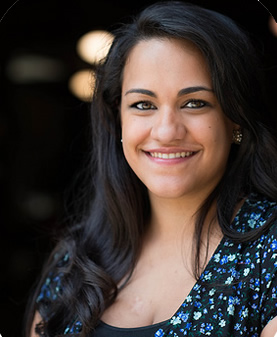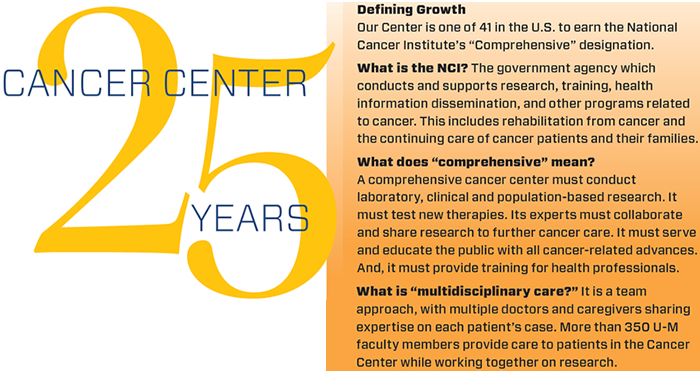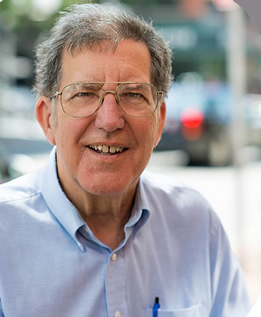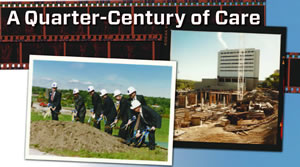Comprehensive Cancer Cures
2013 marks the 25th anniversary of the U-M Rogel Cancer Center. What better way to celebrate than speak to patients treated way back when…who are still cancer-free today.
Here are the stories of two Rogel Cancer Center patients who beat the disease and whose lives were enriched by the experience of healing.
Regina Royan

Birthdate: Dec. 17, 1987
Diagnosis:Acute Lymphoblastic Leukemia (ALL )
U-M Doctor: Laurence Boxer, M.D.
Age at diagnosis: 5
Regina Royan’s mother worried when her 5-year-old daughter kept running a low-grade fever. A complete blood count revealed acute lymphoblastic leukemia, the most common type of cancer in children, a disease of the blood and bone marrow. She remembers some of the painful things, like spinal taps and bone marrow tests. She remembers the frequent drives from her home in Howell, Mich., to Ann Arbor, which seemed like it took hours as a child. And, she remembers the parties on the seventh floor of Mott Children’s Hospital for birthdays, holidays and children who had completed treatment.
"At Christmas, we did a make-believe trip to the North Pole, where we actually went to the Detroit airport, got on a plane and visited Santa. It was really awesome stuff. Sheila Morris in Child Life did such a tremendous job giving kids things to look forward to when they were in the hospital."
After three years of treatment and five years of follow-up tests, Royan was officially cured and now visits her primary care doctor for an annual physical, just like any other healthy 25-year-old.
How cancer changed her life
"Dr. Boxer was such a big influence on my young life and an interest in medicine seemed like a natural fit. When I was in high school, I sent him an email and asked if I could come to the hospital and shadow him. He gave me a great opportunity to learn."
Royan received degrees in biology and political science from Eastern Michigan University and a master’s in epidemiology from the University of Michigan. Her goal is to attend the U-M Medical School to become a physician.
Improvements she's noticed in care
"It's great to see targeted treatments starting to come out that don't affect healthy cells like traditional therapy did. Side effects aren’t as bad. Kids don't get as sick. They have a better quality of life to maintain an active childhood."

Clark Charnetski

Birthdate: Jan. 17, 1942
Diagnosis: Bladder Cancer
U-M Doctor: James Montie, M.D.
Age at diagnosis: 54
In the spring of 1996, Clark Charnetski had a backache. Initially suspecting a urinary problem, an X-ray with dyes found a tumor. Within a few hours, he had an appointment with James Montie, M.D., who diagnosed bladder cancer. That summer, Charnetski underwent chemotherapy and radiation to shrink the tumor before surgery.
"Chemo at the time was very difficult," he says. "I was really sick, especially combined with the radiation. I was in a wheelchair by the end, just because I was so weak. I had to recover physically before surgery."
Charnetski remembers turning to his one-person sailboat for exercise to get his strength back. He still sails the boat today.
In surgery, Montie discovered the tumor was entirely encased in scar tissue. This was good news: it meant the chemo and radiation did its job to shrink the tumor. There was no cancer found in surrounding lymph nodes. After a 15-day hospital stay and several months of recovery, Charnetski remains cancer-free.
How he gives back
"The first meeting of the bladder cancer support group met when I was in the hospital for surgery. I missed it, but my wife went down. She and I have gone ever since. As time goes by, there are people there facing surgery or who have recently had it. It gives them hope to see someone who has survived all these years."
What he's most grateful for:
"At one point, I was worried I wouldn't live to see the 21st century," Charnetski says.
He remembers attending a millennium party, watching the clock and being happy when the lights stayed on at the turn of the century.
Since his diagnosis in 1996, he’s also seen his son get married, has two grandchildren (now 11 and 13) and retired from his job as a physicist to participate on committees working to improve transportation issues for senior citizens and people with disabilities.
Continue reading the Fall, 2013 issue of Thrive

